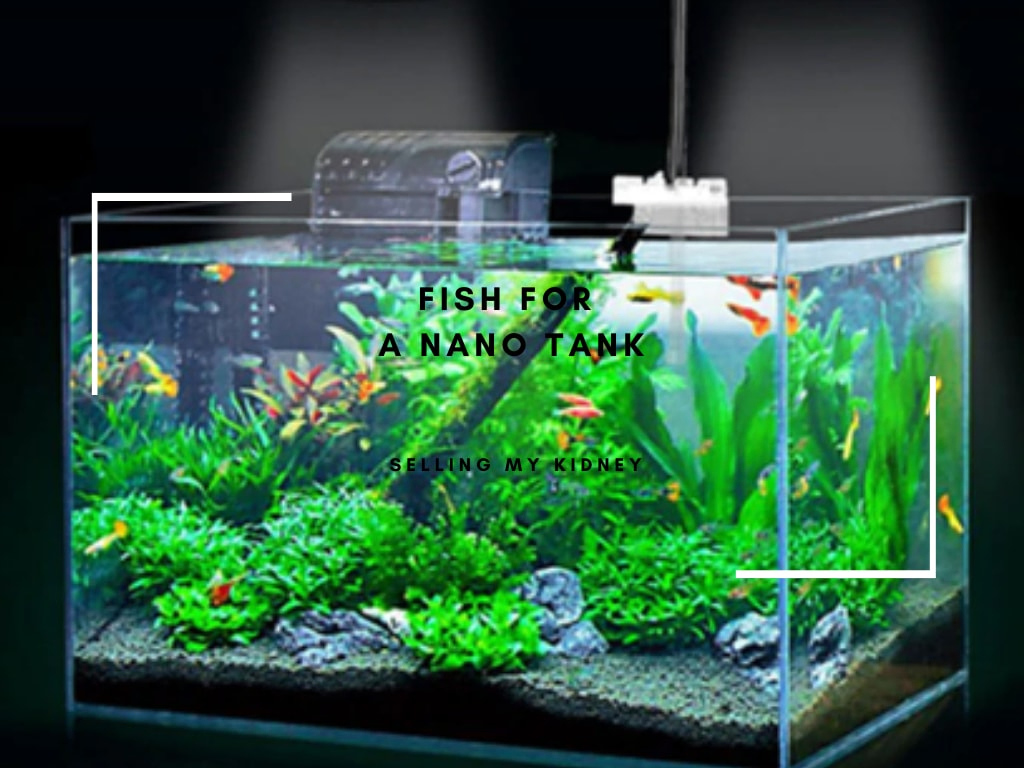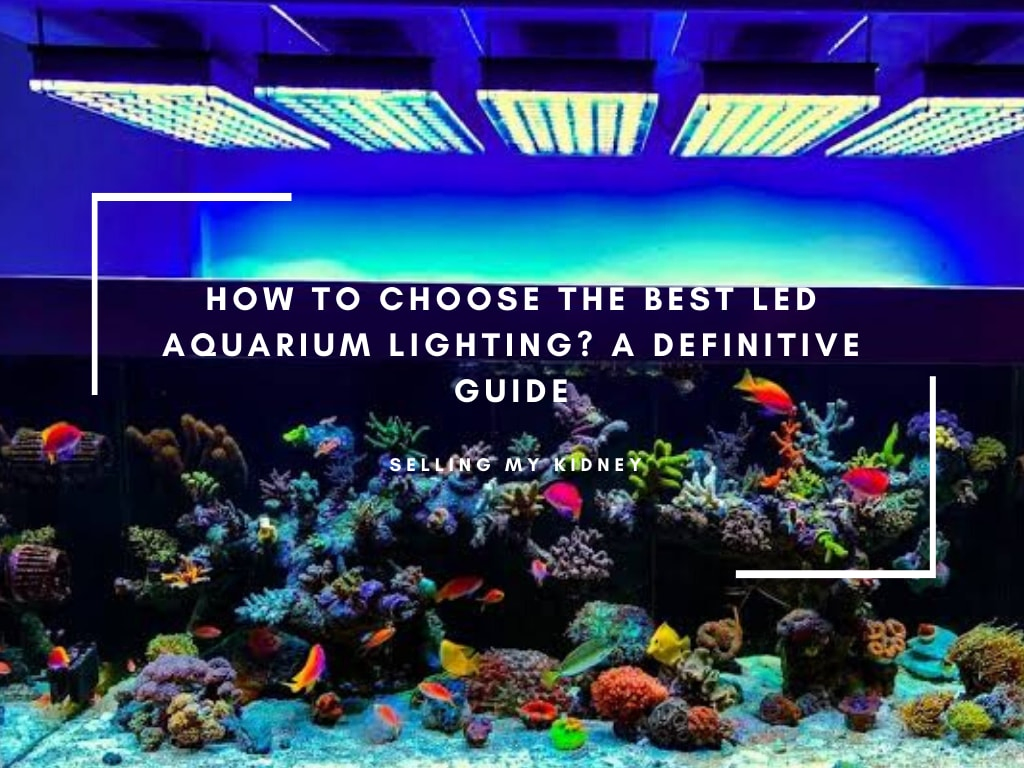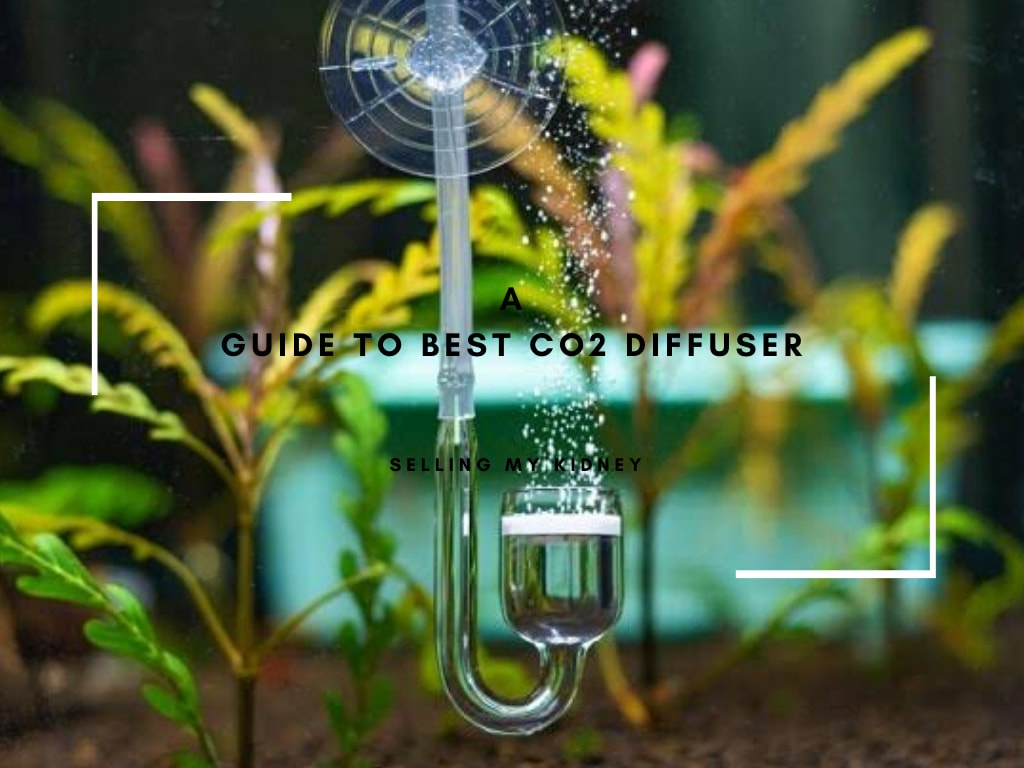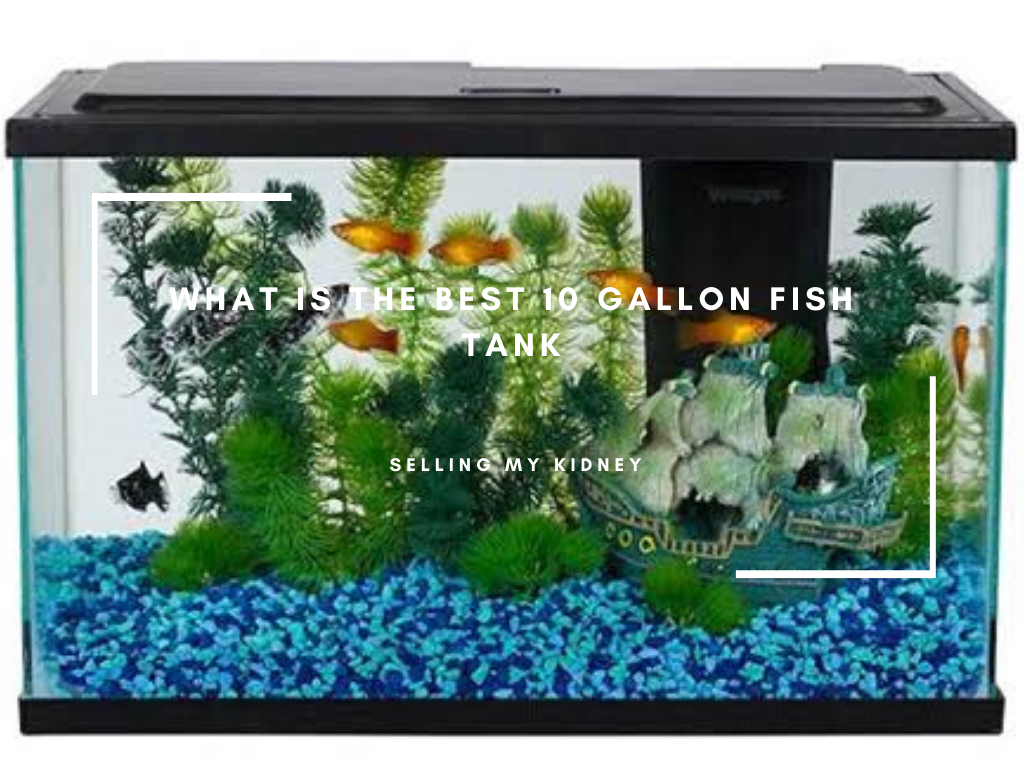Aquariums don’t have to be huge and flashy. There are many models which have a kind of minimalist elegance to them.
Nano tanks are popular among hobbyists due to their petite size and aesthetic appeal. They can be a perfect addition to a kitchen counter, classroom or even an office desk.
However, with the tiny space comes some special restrictions.
In addition to a heightened need to pay attention to water quality, there are also restrictions on what fish can actually thrive in such an environment.
Adding the wrong creatures to your nano tank can lead to unnecessary fatalities. Do you know how you should be populating your nano tank?
What counts as a nano tank?

As the name suggests, a nano tank is a very tiny aquarium. They generally refer to both salt and freshwater aquariums of no bigger than 10 gallons.
Nano tanks can sometimes be up to 20 gallons, depending on what you want to put in them.
They come in a whole variety of shapes and sizes, depending on your requirements. They can be square, spherical, or even small cylinders.
It’s important that you realize going into this adventure that small tanks do not equate to less maintenance. In fact, the reality is quite the opposite.
Depending on the fish which live in your tank, they can require a watchful eye. This is especially true when it comes to monitoring water quality, which is more prone to problems due to the small water volume.
While freshwater nano systems are much easier to deal with than saltwater, it’s incredibly important that you still put some consideration into which fish you want to add to your system.
What are the best fish for nano tanks?
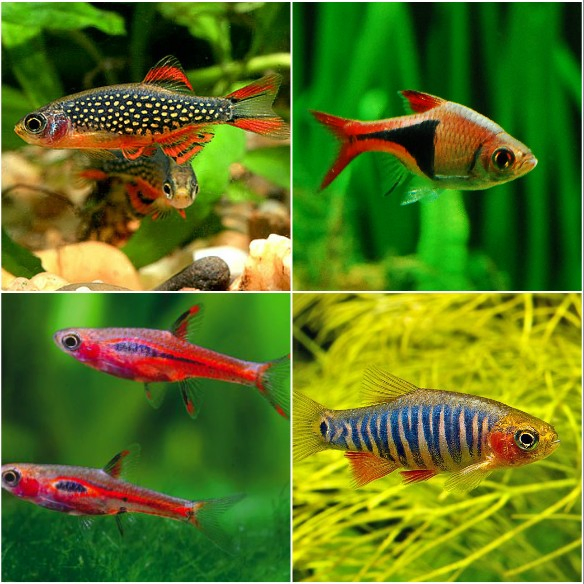
When people think of nano tanks, their minds tend to jump to moss balls and shrimp. While these are certainly options for you, the world of nano tanks is much bigger than you might have imagined!
Consider the following popular nano tank fish as potential additions to your aquarium:
1. Chili Rasbora (Boraras brigittae)

The chili rasbora is one of the smallest freshwater tropical fish available in the aquarium trade. These vibrant red fish are relatively hardy and like to be a part of a school if possible.
- Min. tank size: 5 gallons
- Temperature: 74 – 82°F
- pH: 6-7
- Diet: mostly carnivorous
2. Neon Tetra (Paracheirodon Innesi)

Neon tetras are another simple and peaceful addition to a tropical freshwater tank. Their bright and fun colors make this schooling fish an aquarium staple for tanks of all sizes.
- Min. tank size: 10 gallons
- Temperature: 70 – 81°F
- pH: 6-7
- Diet: omnivorous
3. Cardinal Tetras (Paracheirodon Axelrodi)

These freshwater fish are a slightly chubbier version of their cousins, the neon tetra. These active fish are eye-catching – just be sure that the dimensions of your tank can accommodate their active lives.
- Min. tank size: 10 gallons
- Temperature: 73 – 81°F
- pH: 4.5-7
- Diet: omnivorous
4. Bettas (Betta Splendens)
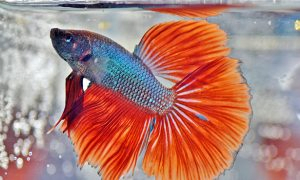
The humble betta is known for its hardy nature and its ability to live in small freshwater set-ups. Its striking color makes for an excellent addition in the right community.
- Min. tank size: 2.5 gallons (but preferably 5)
- Temperature: 78 – 80°F
- pH: ~7
- Diet: carnivorous
5. Harlequin Rasboras (Trigonostigma Heteromorpha)

This metallic freshwater fish will add a little shimmer and sparkle to any tank. This tiny fish enjoys swimming among plants, preferably live ones.
- Min. tank size: 10 gallons
- Temperature: 73 – 82°F
- pH: 6-7.5
- Diet: omnivorous
6. Fancy Guppies (Poecilia Reticulata)

The guppy has become a rite of passage for many hobbyists as this small freshwater fish is notoriously hardy and easy to breed. They can add a splash of color to any nano tank.
- Min. tank size: 5 gallons
- Temperature: 55 – 85°F
- pH: 7-8
- Diet: omnivorous
7. Endler’s Livebearers (Poecilia Wingei)
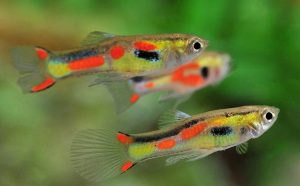
The Endler’s livebearer is comparable to the guppy in terms of looks and behavior. This elegant freshwater fish is full of personality with just a dash of color.
- Min. tank size: 20 gallons
- Temperature: 75-81°F
- pH: 7-8.5
- Diet: omnivorous
8. Zebra Danios (Danio Rerio)

Zebra danios are a much more subtle addition to a freshwater tank. What they lack in striking colors they more than makeup for in personality, which makes them a fun addition to a natural-looking tank.
- Min. tank size: 10 gallons
- Temperature: 77-82°F
- pH: 6-8
- Diet: omnivorous
9. Bluefin Notho (Nothobranchius Rachovii)
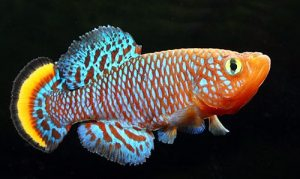
This beautiful species of killifish remains one of the most popular of its kind in the freshwater aquarium trade. They may prove challenging to keep, but they are well worth the work.
- Min. tank size: 20 gallons
- Temperature: 72-75°F
- pH: 6-8
- Diet: carnivorous
10. White Cloud Mountain Minnow (Tanichthys Albonubes)
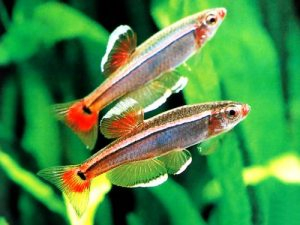
Although this freshwater fish is commonly seen as a “feeder” for turtles and larger fish, it makes a great pet. Its pastel, metallic scales add something special to a freshwater nano tank.
- Min. tank size: 10 gallons
- Temperature: 64-72°F
- pH: 6.5-7.5
- Diet: omnivorous
11. Celestial Pearl Danio (Danio Margaritatus)

This species of danio can also add a soft pop of color to a freshwater nano tank. Their intricate patterns are gorgeous, but this delicate species is solely for experienced hobbyists.
This fish is sometimes referred to as the galaxy rasbora as its metallic white spots resemble stars.
- Min. tank size: 10 gallons
- Temperature: 73-79°F
- pH: 6.5-7.5
- Diet: omnivorous
12. Sparkling Gourami (Trichopsis Pumila)
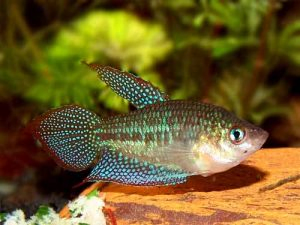
A sparking gourami offers a way of adding polka dots to a freshwater tank without much effort. Its sparking scales make it akin to a galaxy – a shining star in a well-lit nano tank.
- Min. tank size: 10 gallons
- Temperature: 72-78°F
- pH: 6-7
- Diet: omnivorous
13. Pygmy Corydoras (Corydoras Pygmaeus)
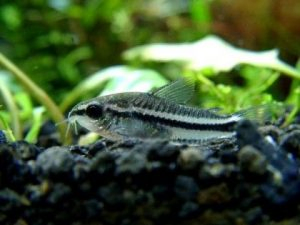
Cory catfish have long been a popular choice among freshwater hobbyists of all experience levels. This adorable, chubby fish adds some energy to the bottom of your tank.
- Min. tank size: 20 gallons
- Temperature: 72-79°F
- pH: 5.8-7
- Diet: omnivorous
14. Oto Cats (Otocinclus Macrospilus)

At the other end of the effort spectrum is oto cats. These slender fish can also add some activity to your benthic levels, but they require a little more experience.
- Min. tank size: 10 gallons
- Temperature: 74-79°F
- pH: 6.8-7.5
- Diet: herbivorous
15. Norman’s Lampeye Killifish (Poropanchax normani)
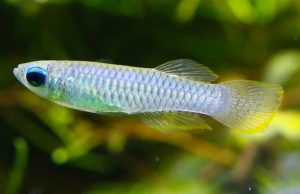
This eerie fish is known for its cute, cartoon-like appearance. This incredibly easygoing freshwater fish is quick to spawn and friendly to almost all potential nano tank inhabitants.
- Min. tank size: 20 gallons
- Temperature: 73-78°F
- pH: 6.5-7
- Diet: carnivorous
16. Bumblebee Goby (Brachygobius doriae)
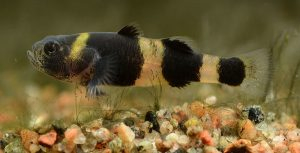
This pouty little goby can be a precious member of a brackish tank, but don’t let its tiny demeanor fool you! They will try to swallow anything which can potentially fit in their mouths.
17. Pygmy Hatchetfish (Carnegiella myersi)
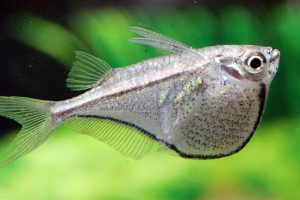
This uniquely shaped freshwater fish will be sure to catch your eye. Its oblong body and translucent coloration make it rather distinct compared to other contenders on this list.
As cool as this fish looks ,it can be a little difficult to get hold of. It may be wise to check out a specialty store as local pet shops seldom have these in stock.
- Min. tank size: 10 gallons
- Temperature: 73-78°F
- pH: 5.5 – 6.5
- Diet: carnivorous
18. Gulf Coast Pygmy Sunfish (Elassoma gilberti)

This dark and striking black and blue fish is comparable to a betta fish in its elegance. This freshwater fish has gorgeous fins and highly contrasting scales.
19. Dwarf Pencilfish (Nannostomus marginatus)
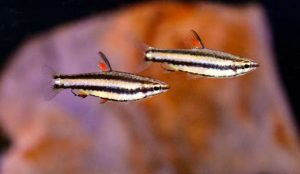
This slender little freshwater fish has a surprisingly fitting name. Its small demeanor makes it an excellent addition to a community tank. While they don’t need to live in large schools, they must at least have a few other dwarf pencilfish to pal around with.
- Min. tank size: 15 gallons
- Temperature: 75-78°F
- pH: 6.8-7.5
- Diet: omnivorous
How to set up a nano aquarium

Setting up a nano aquarium is no different to any other tank. There are some things which you really must keep in mind when trying to maintain a nano tank.
Once you have picked out which fish and other creatures will live in your tank, you can begin to explore what you need to get or prepare in order to get your nano tank up and running.
- Tank and tank size
People choose nano tanks for a variety of reasons. For the most part, people choose to set up tanks due to the convenience of space or a passion for nano fish.
Depending on the small aquarium species you decide to raise, you must find the right shape and size for you.
Different dimensions can benefit different fish. What you need for a killifish nano tank will be different from that which you need for a shrimp aquarium.
Schooling nano fish will require more space than a solo fish in most cases, as they like to swim in unison.
Solitary and relatively inactive species, such as a betta, don’t necessarily require so much open space.
Choosing the tank is actually one of the easier parts of the nano fish tank setup process.
- Filtration
A tiny tank needs good filtration. Having a lower volume will cause the aquarium to become dirty faster.
On a superficial level, cloudy tanks look bad and they can make it difficult for your fish to navigate and also make it an eyesore.
A dirty tank will also smell bad after a while. This is due to a build-up of bacteria and ammonia levels.
These chemicals are not only annoying but are harmful and potentially lethal to your nano fish.
While some types of nano fish are more sensitive to this than others, there are no fish which enjoy poor water quality.
There are many ways in which you can address these problems. Firstly, you must exercise sufficient maintenance of the tank.
This means that you should conduct regular water changes to your set-up and make sure to perform water quality tests periodically.
Another smart move to make is to invest in a filter – check our guide for HOB filter-. There are a variety of filters which are perfectly designed for nano tanks.
Make sure to use the proper filter as improperly sized filtration devices are inefficient. One which is too small won’t clean, and one which is too big may create too strong a current.
Another smart move you can make is planting live plants in your tank.
- Plants And Décor:
Planted nano tank setups generally have better water quality. Plants can help clean the water and provide oxygen to your fish.
In a nano aquarium, you need all the help you can get to keep the water clean. Apart from that, plants and décor can add enrichment to your nano aquarium.
While fish don’t require too much entertainment, they do like to have things to swim through and look at.
Your fish will appreciate having additional plants and décor to swim amongst. Most people find that they also enjoy having the aesthetic appeal of the plants.
There are many plants which can thrive in nano tanks. Some of the more popular options include Christmas Moss, Fissidens fontanus, Hemianthus glomeratus, Anubias nana, and moss balls.
- Substrate: gravel, sand, and soil
Plants and décor are not the only sources of enrichment. Different substrates should also be used.
There are no perfect substrates for nano aquariums. Instead, try to research which substrates work best for the plants and fish which live in your tank.
- Lighting
Small light fixtures can also be purchased for nano tanks. It is important to know the living requirements of the plants and fish you have in your aquarium.
Coral, for example, requires a very different light fixture than a seahorse. Try to take these things into consideration when deciding on a light for your aquarium.
LED lighting is often recommended as it is economically efficient, and does not contribute to changes in water temperature.
- Heating
The final component to consider in your set up is heating. Different fish have different temperature requirements.
If you have tropical fish such as bettas or tetras, you will need to use a heater at least part of the time.
Small stick heaters can be purchased, which are designed with small tanks in mind. They come with a feedback mechanism to prevent boiling your tank.
If you decide to fill your tank with cold water nano fish, you may be able to get away without a heater.
Just make sure to have a thermometer nearby (or fixed in the tank), so you can closely monitor the levels in your tank.
Nano tanks have become a rather popular craze which embodies our love for aquarium keeping and our passion for minimalism.
Having one of these cutting-edge tanks is easier than you might think! A little bit of research can go a long way.
Have you created a successful nano tank? We’d love to hear from you!
Feel free to share your comments and experiences below.

